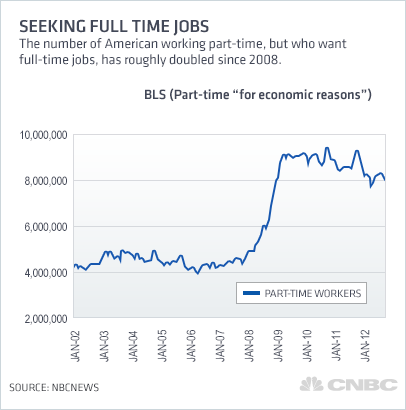In 2008, Marcey Carver lost her job in the finance department of a Vermont car parts maker that closed its doors after the auto industry went into freefall.
With a degree in molecular biology, an MBA and a master's in accounting, Carver, 58, spent the next year and a half working temporary jobs, landing full-time work in October 2009 as finance director for a small non-profit. After 11 months, she was laid off again.
Since then she’s had temporary jobs, but her search for full-time work has run into a major roadblock.
“You can’t get the job you’re qualified for," she said. “But you can’t get a job you’re overqualified for because they think you’re going to quit as soon as you find something else.”
Carver doubts she'll ever land full-time work and now focuses on just making enough money to pay the bills.
Millions of other Americans have come to the same conclusion as the worst economic recovery since World War II has left them sidelined and unable to replace the job they lost to the Great Recession.
Many have given up altogether, left behind by the economy and left out of the government’s employment statistics. In fact, so many people have given up looking for work that the official jobless rate fell to 8.1 percent last month from 8.3 percent, even though the economy is not adding nearly enough jobs to absorb the growth in working-age population.
With the presidential election just weeks away, President Obama and former Massachusetts governor Mitt Romney squared off Wednesday night in the first of three campaign debates. The discussion focused heavily on which candidate has the better plan to spur the economy and create jobs more quickly.
On Friday, the Bureau of Labor Statistics will report September employment data and is expected to show another month of modest job growth that will leave the unemployment rate little changed.
Nobody knows exactly how many people have given up looking and left the workforce. The BLS monthly household survey has a relatively large margin of error, and the pool of "discouraged workers" is not static – people move in and out of the category from one month to the next.
But the pool is growing. Since last August, the official count of people who have left the work force but still want a job has risen by a half-million, to just over 7 million. That doesn't include the roughly 8 million "underemployed" people with part-time jobs who want full-time work, double the number when the 2007 recession began.
Millions of retirees also have left the labor force this year. That category has been growing as the outsized baby boom generation grows older.
But relatively few boomers approaching the phase of life traditionally called “retirement” can look forward to the pension checks that helped past generations pay the bills in their "golden years." For many, the individual retirement accounts that were supposed to replace pension incomes have been severely damaged by the financial collapse and by the drain on savings from extended unemployment since.
Older workers on the sidelines say that without that financial cushion, their current status can hardly be thought of as "retirement."
“It means no vacations, no repairs to my house, almost never eating out, no going out to a movie or other entertainment, no new clothes, dreading opening the mail, juggling paying bills, knowing every time you spend money, it is just adding to debt that there is little likelihood of paying off,” said Carver.
As more baby boomers have left the official count of the labor force, a decades-long expansion of women working full-time has slowed. Those forces explain about half the shrinkage in the labor force participation rate, according to economists at the Chicago Federal Reserve.
The rest of the drop is the result of the grim prospects job seekers face in the current stagnant economy, according to Federal Reserve Chairman Ben Bernanke.
“Some people, because they have essentially given up or at least they're very discouraged, have decided to leave the labor force," he told reporters last month.
The high level of unemployment "imposes hardship on millions of people, and it entails a tremendous waste of human skills and talents," said Bernanke."As the skills of the long-term unemployed atrophy and as their connections to the labor market wither, they may find it increasingly difficult to get good jobs, to their and their families’ cost, of course, but also to the detriment of our nation’s productive potential."
Concerned about the long-term impact of long-term unemployment, the Fed has begun a new round of bond buying designed to lower interest rates and spur more hiring.
With nearly three unemployed workers for every new job opening, it’s not hard to see why people get discouraged. For many job seekers, the odds are much longer.
Indelethio Nebeker, 37, with a degree in communications and experience as corporate trainer, has been looking for full-time work for several years. He recently was up against 700 other applicants for an opening at a Louisiana pharmaceutical company. The interview process took five months.
After filling out an application, he got a call back and was asked to answer questions online. Then came a second call back for a preliminary phone interview, followed by a request to produce a five-minute video and write a personal statement. Then came a second phone interview, followed by a trip to the company for a 25-minute audition and a meeting with the hiring managers. More than a month later, a company manager called to break the news that they “had decided to go in a different direction.”
Up for another entry level job with a different company, he said, the interviewer recently asked why he was interested in a job that paid less than someone with his experience would typically expect to earn.
“I thought, ‘Because it’s the only one you’re offering. Have you looked around?” he said. “It seems like the people that are hiring have no clue about what’s going on out here.”
In the meantime, Nebeker is doing odd jobs, including part-time work as a driver’s education instructor while he keeps up an intermittent job hunt.
“I've stopped, I've started again, and I've stopped again,” he said. “It's a constant roller coaster.”
George Morris, 30, has been looking for a full-time job in advertising since he was laid off from his last one in February 2010. Since then he’s been working a series of related odd jobs, including photographer's assistant and writer for a website. He’s also paying the bills with unrelated jobs, from getting paid as a clinical test subject to suing telemarketers for illegal calls.
Those jobs are generating income. But they’re no substitute for the experience Morris needs to build traction in his career.
“People were laid off during the recession with more experience than I have,” said Morris. "But I can’t get enough depth in my field to keep up because I can’t get a company to pay me a living wage.”
For those sidelined from full-time work, odd jobs are critical to financial survival. But they also create an obstacle when it comes time to interview for the next full-time positions.
“(Employers) look at my resume and say, ‘Could you go back into a full time position when you’ve been doing this other stuff for so long?’” said Nebeker. “I look at them and think. ‘What are you talking about? I need a job.’”
Based on recent data, the odds of finding a job are improving – but very slowly. Since the recession ended in June 2009, roughly 140,000 net new jobs have been created every month. That’s barely enough to keep pace with the growth of the working-age population.
Economists point to continued gains in productivity to explain how companies have managed to increase profits with so little new hiring. Some job seekers agree.
“I think (companies) figure, ‘We’ve done so long without replacing all these positions, we’re just going to make people do more work so we don’t have to hire more people,'” said Nebeker.
The search for a traditional, full-time job with benefits has become tougher as companies rely more heavily on short-term, contract assignments to fill empty positions until the economy is on a stronger footing.
Many employers also complain that uncertainty about changes in tax policy and health care costs have forced them to delay hiring decisions until the outlook becomes clearer.
Employers may also be slow to create full-time jobs with benefits because the large pool of jobless workers makes it easy to get the same work done with temporary and part-time workers at a lower cost.
“The loss of unions has played a major part in it,” said Morris. “There’s no collective bargaining. It’s become a very asymmetrical: ‘Here’s what I’ve got offer. Take it or leave it.’”
Morris is still hopeful the laws of supply and demand will eventually swing back in his favor. But it may take time.
“When I was in college, the unemployment rate was at a 4 percent rate, and if you could spell your own name right you could get hired,” he said. “The pendulum has swung the other way. I don’t think the pendulum is going to fall off and go away. But I do think we’re looking at painful cyclical changes that are going to go on for some time.”
This story originally appeared on NBCNews.com.



